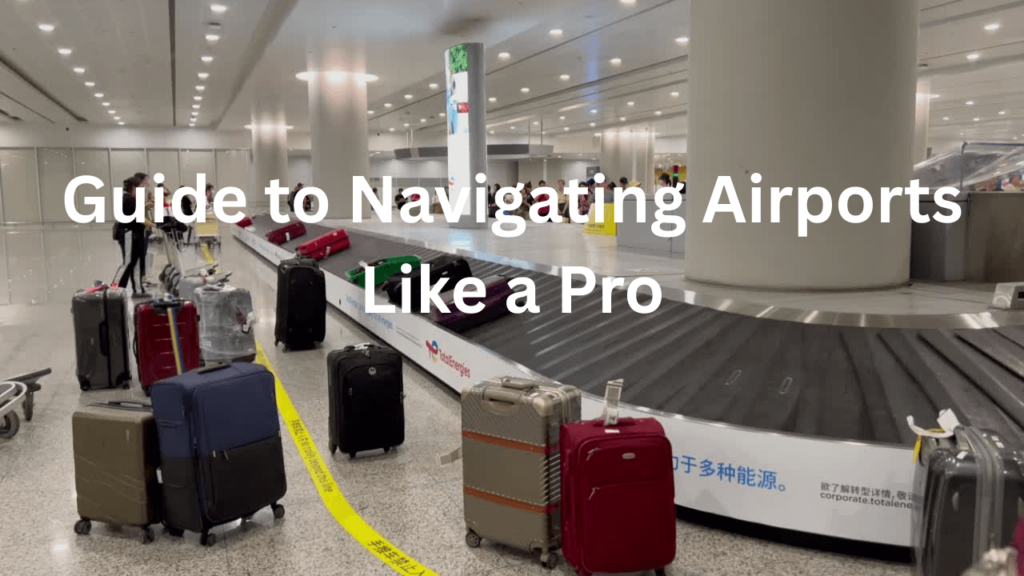Airports are fascinating places. They serve as gateways to adventure, business, and family reunions. But they can also be overwhelming, stressful, and downright confusing—especially for first-time flyers or travelers rushing through multiple connections. In today’s fast-paced travel world, where millions of passengers pass through airports daily, knowing how to navigate airports efficiently isn’t just a convenience—it’s a survival skill.
I’ve personally experienced the spectrum of airport travel, from the seamless efficiency of Singapore’s Changi to the chaos of delayed flights in New York. What I’ve learned is that navigating airports is less about luck and more about preparation, strategy, and mindset. In this article, I’ll share research-backed insights, real-world examples, and practical tips that will help you turn airport travel from a dreaded chore into a manageable—even enjoyable—part of your journey.
Why Airport Navigation Matters Today
Modern air travel has become more complex. Increased security measures, larger airports, and the rise of budget airlines with stricter policies all add to the challenge. According to the Airports Council International, global passenger traffic exceeded 8 billion in 2023, and this number continues to grow. With this surge, airport congestion, longer security lines, and flight delays are increasingly common.
Knowing how to navigate airports efficiently can:
- Save you time and stress.
- Prevent missed flights.
- Improve your overall travel experience.
- Even save money by helping you avoid costly mistakes like overweight baggage fees or missed connections.
For families, business travelers, or even solo backpackers, mastering airport navigation is a skill that pays off every single trip.
Preparing Before You Reach the Airport
1. Book Smart Flights
Your airport experience begins long before you set foot in the terminal. When booking flights, consider:
- Connection times: Avoid overly tight layovers. Experts recommend at least 90 minutes for domestic connections and 2-3 hours for international.
- Airport hubs: Some airports are notorious for delays. Research your connecting airport’s reputation before booking.
From experience, I once had a 45-minute layover in Frankfurt. With long security checks and a terminal change, I almost missed my flight. Since then, I always allow more buffer time.
2. Check-In Online
Most airlines allow online check-in 24 to 48 hours before departure. Doing this saves time, lets you choose better seats, and often allows mobile boarding passes to be stored on your phone.
3. Organize Your Documents
Keep your passport, visa, ID, and boarding pass accessible. A simple travel wallet or phone case with a card holder can reduce fumbling in line.
Packing for Airport Success
1. Follow Baggage Rules
Each airline has its baggage allowance and rules. Overweight or oversized luggage can mean hefty fees. Research these ahead of time to avoid surprises.
2. Pack Essentials in Your Carry-On
Include:
- Travel documents
- Medications
- Electronics
- Snacks
- A change of clothes (in case of delays or lost luggage)
Personally, I once had my checked bag delayed for two days in Rome. Thankfully, I had packed essentials in my carry-on, which saved the trip from being ruined.
3. Streamline for Security
Follow the 3-1-1 rule for liquids: each container must be 3.4 ounces (100 ml) or less, all fitting in one clear quart-sized bag, with one bag per traveler. Wear slip-on shoes and avoid excessive jewelry for quicker security checks.
At the Airport: Step-by-Step Navigation
1. Arriving at the Airport
- For domestic flights, arrive 2 hours early.
- For international flights, 3 hours is safer.
Arriving early gives you buffer time for traffic, long check-in lines, or unexpected delays.
2. Check-In and Baggage Drop
If you didn’t check in online, head to your airline’s counter or kiosk. Drop your bags here, making sure they are tagged correctly. Always keep your baggage claim receipt.
3. Security Screening
Security can be the most stressful part of airports. To speed it up:
- Have your ID and boarding pass ready.
- Remove laptops and liquids.
- Wear minimal accessories.
- Join the queue with business travelers; they tend to move faster than families with children.
4. Immigration and Customs (International Travel)
Always check visa requirements beforehand. For example, U.S. travelers to Europe must now consider the upcoming ETIAS system. Be polite and answer only what’s asked.
5. Finding Your Gate
Airports can be sprawling. Use signage, information desks, or airport apps to navigate. Give yourself time to walk—some airports like Doha or Istanbul can take 20-30 minutes to get from security to your gate.
Making the Most of Your Time at the Airport
1. Use Airport Lounges
Even if you’re not flying business class, many lounges offer pay-per-use options. Lounges provide comfortable seating, Wi-Fi, snacks, and showers—worth it during long layovers.
2. Stay Entertained and Productive
Download movies, podcasts, or audiobooks before your trip. Many airports now also have dedicated workspaces, free Wi-Fi, and charging stations.
3. Eat Smart
Airport food is notoriously overpriced. Bring snacks or reusable water bottles (fill them after security). If you must buy meals, research which terminals have better food options—some airports even feature local specialties.
Navigating Common Airport Challenges
1. Flight Delays and Cancellations
Always monitor your flight status through apps like FlightAware or the airline’s app. If delays happen, get in line at the counter but also call the airline’s helpline simultaneously—sometimes phone agents rebook faster than in-person staff.
2. Missed Connections
If you miss a connecting flight due to delays, the airline is usually responsible for rebooking you. Approach staff calmly but assertively—politeness goes a long way.
3. Lost Luggage
Report lost luggage immediately at the airline’s counter. Most airlines deliver delayed bags within 48 hours. Having a carry-on with essentials can save the day.
Tech Tools for Airport Navigation
- Airline Apps: Real-time updates, digital boarding passes.
- Google Maps / Airport Maps: Some airports are mapped for indoor navigation.
- Flight Tracking Apps: Monitor flight delays or gate changes.
- Translation Apps: Helpful in non-English-speaking airports.
Tips for Families and Special Travelers
Families with Kids
- Use family lanes at security.
- Pack entertainment (toys, coloring books, tablets).
- Bring snacks kids are familiar with.
Elderly Travelers
- Request wheelchair assistance ahead of time.
- Allow extra time for boarding.
Business Travelers
- Invest in TSA PreCheck, Global Entry, or CLEAR for faster security.
- Carry a power bank to stay connected.
The Human Side of Airports
Beyond logistics, airports are emotional places. They’re where families reunite, goodbyes are said, and adventures begin. Keeping a calm mindset helps you deal with inevitable frustrations. I’ve learned to see airports not just as transit points but as part of the journey itself. From people-watching in London Heathrow to enjoying a surprise piano performance at Dublin Airport, these experiences can add richness to your travels.
Final Thoughts: Mastering Airport Travel
Navigating airports doesn’t have to be stressful. With preparation, awareness, and the right mindset, you can move through even the busiest airports with confidence. From booking smart flights and packing correctly to breezing through security and handling delays like a pro, each step becomes easier with practice.
The next time you find yourself in a crowded terminal, remember: airports are just another stage of the journey. Treat them with patience, use the tools available, and stay flexible. Before you know it, you’ll be the traveler others look at and wonder, “How do they make it look so easy?”

Hi, I’m Tanvir, the founder and author of Explore Ireland Now. With a deep love for Ireland and its rich culture, history, and landscapes, I created this site to share everything that makes this beautiful country worth exploring. Whether you’re a local looking for hidden gems or a traveler planning your next adventure, I provide insightful guides, tips, and recommendations to help you experience Ireland to the fullest.
From stunning landscapes to vibrant cities and quaint villages, Ireland is full of wonders waiting to be discovered. Through my personal experiences and research, I aim to bring you the most up-to-date information and inspiration for your journey.
Thank you for visiting Explore Ireland Now—I hope my content helps you uncover all that this incredible country has to offer! If you have any questions or need travel advice, feel free to reach out.



